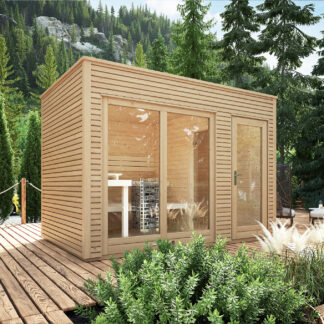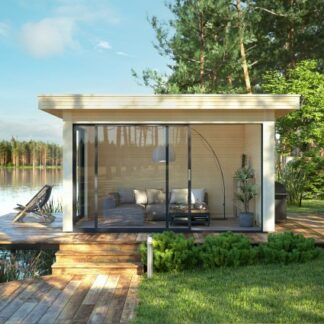Log cabins look cosy and cute and warm. They have so many endearing qualities. They look so inviting: you just want to go in there and sit down by the stove and relax. But do they stay warm for long?

Easy and cheap to heat
You want a warm, cosy log cabin.
At timber living, all of our residential log cabins are very well insulated. We are very proud of the high quality of build of our log cabins. We use only the best materials, and that makes our log cabins reliable, durable and warm.
There are two factors that ensure that a building is
-
heats quickly
-
retains the heat
As long as a building has sufficient insulation and is well draught-proofed, heating should not be a major issue. The major difference between a log cabin and a block built building is that the blocks used tend to draw heat out of the rooms, and in effect, they need to be heated sufficiently before the room really feels warm. These cold surfaces will make the room feel cold until they are warmed up themselves. You do not have this issue with timber walls, floors and ceilings.
Our log cabin walls are one hundred and seventy five millimetres thick (seven inches). Of that 157mm, you have a 45mm outside timber, a 100 mm cavity and a 30mm inside timber. The outside and inside timber walls also add to the insulating value of the walls. This all means that a log cabin is going to heat up a lot quicker than a block building, its going to feel warmer sooner than a block building, its going to be cheaper to heat and its going to retain its heat longer.
In the showhouse in Boyle, we generally heat the stove until about four in the afternoon on a Saturday. When we go into the showhouse on the following Sunday morning, the temperature is usually a reasonable 12-14 degrees, even though it is 3 degrees outside.
What insulation does my log cabin need?
Our standard insulation levels are 100mm of kingspan insulation in the roof, and 100mm of Metac insulation in the walls, along with 50mm of kingspan insulation in the floor of your log cabin. While building regulations look for higher levels of insulation in all new buildings, we find that our customers have been happy with these standard levels of insulation ever since we started building log cabins in Ireland, over twenty years ago.
That being said, it is not a problem for us at Timber Living to increase the level of insulation in your log cabin, if that is what you require. Increasingly, people are looking for an increase in the wall, floor and roof insulation. This can be done easily, just by increasing the size of the cavity in the walls, and the roof and floor joist sizes too.
Increasing the size of the cavities and joist sizes in your log cabin will put up the overall cost. But there are other ways to increase the insulation – you could put extra insulation either on the interior walls of your cabin, using cosyboard or a combination of plasterboard and insulation, or you could put external insulation , fixed directly to the external log cabin timbers, on the outside of your log cabin.
The simplest way to increase the insulation in your floor is to build an insulated slab, with load-bearing insulating blocks, such as Quinn Lite.
Is Rockwool okay as floor insulation?
There are many new companies selling log cabins in Ireland, and it is natural that they are bound to make mistakes as they learn the intricacies of building log cabins in Ireland. One of the most common errors made by these companies (and one of the most costly to their customers) is the fact that they offer rockwool as a suitable floor insulation. ROCKWOOL IS NOT A SUITABLE FLOOR INSULATION!
I would advise that the first question you ask any log cabin company you are talking to is “what floor insulation do you use?” If they say rockwool or mineral wool, I would suggest that you walk away. The floor insulation is placed on top of a concrete slab, which naturally, gets very cold in Winter. Once the temperature gets below about four degrees, the moisture in the air in Ireland will stat to condense onto cold surfaces (as we all know too well!) So, with a cold slab on a cold winter’s day, you are bound to get dampness. The rock wool will soak up this dampness like a sponge, and loose its insulation qualities. It will also make your rooms cold and introduce dampness to the floor and wall timbers.
We use Polyisocyanurate (PIR) insulation in our buildings to avoid this damp ingress occurring. Polyisocyanurate (PIR) is one of the most efficient insulation material used in construction. Read more about it here.
Are log cabins warm in the winter?
Our walls are double leaf, cavity walls. Our standard cavity is 100mm and that can be increased if necessary, for planning purposes. In those cavities we make sure that we have the best available insulation. We use foil-backed PIR insulation, commonly known as kingspan insulation, in the roofs and floor spaces. This is a very durable, high-quality product that will last certainly the duration of your log cabin. Our windows and doors are very durable, double-glazed units, which will easily keep out Winter winds. All windows are tilt-and-turn, our external doors are five-point locking, and our internal doors all have gaskets (believe it or not) to keep the heat in.

Well-insulated log cabins
Whether you are building a single storey or a two storey log cabin, and no matter how many bedrooms is in your log house, we can assure you that your new home will be very cosy, warm and easy and cheap to heat.
You will see from our website that we offer a huge range of log cabins:
If you are interested in a quality log cabin, log house or timber home you should contact us at Timber Living.
Timber Living Log Cabin Showhouses in Tullow, Boyle and Carrigaline
We have show houses in Tullow, Boyle and Carrigaline. Please feel free to contact us now to make an appointment and come visit us.



